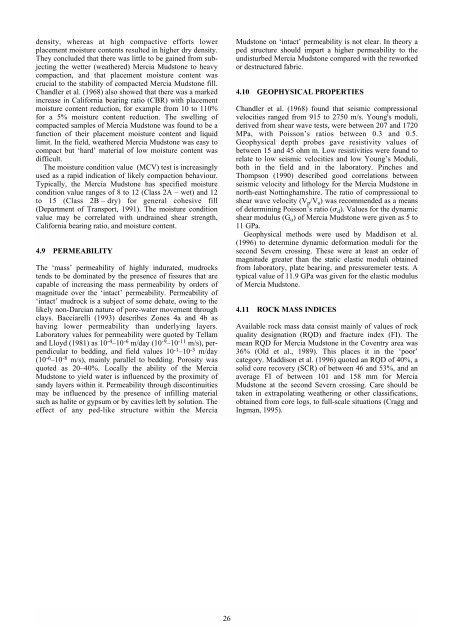Engineering geology of British rocks and soils Mudstones of the ...
Engineering geology of British rocks and soils Mudstones of the ...
Engineering geology of British rocks and soils Mudstones of the ...
You also want an ePaper? Increase the reach of your titles
YUMPU automatically turns print PDFs into web optimized ePapers that Google loves.
density, whereas at high compactive efforts lower<br />
placement moisture contents resulted in higher dry density.<br />
They concluded that <strong>the</strong>re was little to be gained from subjecting<br />
<strong>the</strong> wetter (wea<strong>the</strong>red) Mercia Mudstone to heavy<br />
compaction, <strong>and</strong> that placement moisture content was<br />
crucial to <strong>the</strong> stability <strong>of</strong> compacted Mercia Mudstone fill.<br />
Ch<strong>and</strong>ler et al. (1968) also showed that <strong>the</strong>re was a marked<br />
increase in California bearing ratio (CBR) with placement<br />
moisture content reduction, for example from 10 to 110%<br />
for a 5% moisture content reduction. The swelling <strong>of</strong><br />
compacted samples <strong>of</strong> Mercia Mudstone was found to be a<br />
function <strong>of</strong> <strong>the</strong>ir placement moisture content <strong>and</strong> liquid<br />
limit. In <strong>the</strong> field, wea<strong>the</strong>red Mercia Mudstone was easy to<br />
compact but ‘hard’ material <strong>of</strong> low moisture content was<br />
difficult.<br />
The moisture condition value (MCV) test is increasingly<br />
used as a rapid indication <strong>of</strong> likely compaction behaviour.<br />
Typically, <strong>the</strong> Mercia Mudstone has specified moisture<br />
condition value ranges <strong>of</strong> 8 to 12 (Class 2A – wet) <strong>and</strong> 12<br />
to 15 (Class 2B – dry) for general cohesive fill<br />
(Department <strong>of</strong> Transport, 1991). The moisture condition<br />
value may be correlated with undrained shear strength,<br />
California bearing ratio, <strong>and</strong> moisture content.<br />
4.9 PERMEABILITY<br />
The ‘mass’ permeability <strong>of</strong> highly indurated, mud<strong>rocks</strong><br />
tends to be dominated by <strong>the</strong> presence <strong>of</strong> fissures that are<br />
capable <strong>of</strong> increasing <strong>the</strong> mass permeability by orders <strong>of</strong><br />
magnitude over <strong>the</strong> ‘intact’ permeability. Permeability <strong>of</strong><br />
‘intact’ mudrock is a subject <strong>of</strong> some debate, owing to <strong>the</strong><br />
likely non-Darcian nature <strong>of</strong> pore-water movement through<br />
clays. Bacciarelli (1993) describes Zones 4a <strong>and</strong> 4b as<br />
having lower permeability than underlying layers.<br />
Laboratory values for permeability were quoted by Tellam<br />
<strong>and</strong> Lloyd (1981) as 10 -4 –10 -6 m/day (10 -9 –10 -11 m/s), perpendicular<br />
to bedding, <strong>and</strong> field values 10 -1 –10 -3 m/day<br />
(10 -6 –10 -8 m/s), mainly parallel to bedding. Porosity was<br />
quoted as 20–40%. Locally <strong>the</strong> ability <strong>of</strong> <strong>the</strong> Mercia<br />
Mudstone to yield water is influenced by <strong>the</strong> proximity <strong>of</strong><br />
s<strong>and</strong>y layers within it. Permeability through discontinuities<br />
may be influenced by <strong>the</strong> presence <strong>of</strong> infilling material<br />
such as halite or gypsum or by cavities left by solution. The<br />
effect <strong>of</strong> any ped-like structure within <strong>the</strong> Mercia<br />
26<br />
Mudstone on ‘intact’ permeability is not clear. In <strong>the</strong>ory a<br />
ped structure should impart a higher permeability to <strong>the</strong><br />
undisturbed Mercia Mudstone compared with <strong>the</strong> reworked<br />
or destructured fabric.<br />
4.10 GEOPHYSICAL PROPERTIES<br />
Ch<strong>and</strong>ler et al. (1968) found that seismic compressional<br />
velocities ranged from 915 to 2750 m/s. Young's moduli,<br />
derived from shear wave tests, were between 207 <strong>and</strong> 1720<br />
MPa, with Poisson’s ratios between 0.3 <strong>and</strong> 0.5.<br />
Geophysical depth probes gave resistivity values <strong>of</strong><br />
between 15 <strong>and</strong> 45 ohm m. Low resistivities were found to<br />
relate to low seismic velocities <strong>and</strong> low Young’s Moduli,<br />
both in <strong>the</strong> field <strong>and</strong> in <strong>the</strong> laboratory. Pinches <strong>and</strong><br />
Thompson (1990) described good correlations between<br />
seismic velocity <strong>and</strong> lithology for <strong>the</strong> Mercia Mudstone in<br />
north-east Nottinghamshire. The ratio <strong>of</strong> compressional to<br />
shear wave velocity (V p/V s) was recommended as a means<br />
<strong>of</strong> determining Poisson’s ratio ( d). Values for <strong>the</strong> dynamic<br />
shear modulus (G o) <strong>of</strong> Mercia Mudstone were given as 5 to<br />
11 GPa.<br />
Geophysical methods were used by Maddison et al.<br />
(1996) to determine dynamic deformation moduli for <strong>the</strong><br />
second Severn crossing. These were at least an order <strong>of</strong><br />
magnitude greater than <strong>the</strong> static elastic moduli obtained<br />
from laboratory, plate bearing, <strong>and</strong> pressuremeter tests. A<br />
typical value <strong>of</strong> 11.9 GPa was given for <strong>the</strong> elastic modulus<br />
<strong>of</strong> Mercia Mudstone.<br />
4.11 ROCK MASS INDICES<br />
Available rock mass data consist mainly <strong>of</strong> values <strong>of</strong> rock<br />
quality designation (RQD) <strong>and</strong> fracture index (FI). The<br />
mean RQD for Mercia Mudstone in <strong>the</strong> Coventry area was<br />
36% (Old et al., 1989). This places it in <strong>the</strong> ‘poor’<br />
category. Maddison et al. (1996) quoted an RQD <strong>of</strong> 40%, a<br />
solid core recovery (SCR) <strong>of</strong> between 46 <strong>and</strong> 53%, <strong>and</strong> an<br />
average FI <strong>of</strong> between 101 <strong>and</strong> 158 mm for Mercia<br />
Mudstone at <strong>the</strong> second Severn crossing. Care should be<br />
taken in extrapolating wea<strong>the</strong>ring or o<strong>the</strong>r classifications,<br />
obtained from core logs, to full-scale situations (Cragg <strong>and</strong><br />
Ingman, 1995).

















